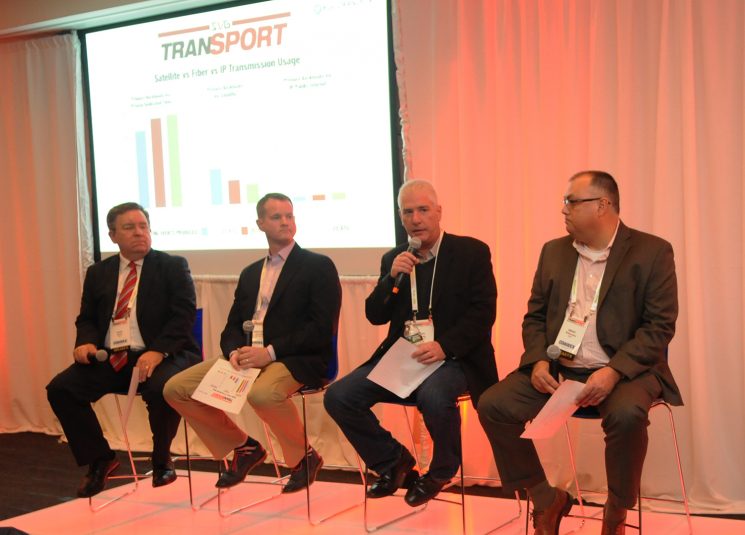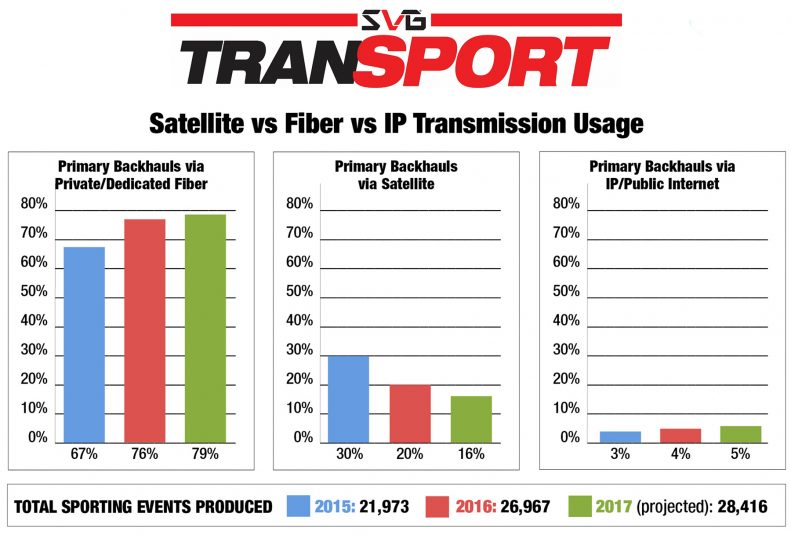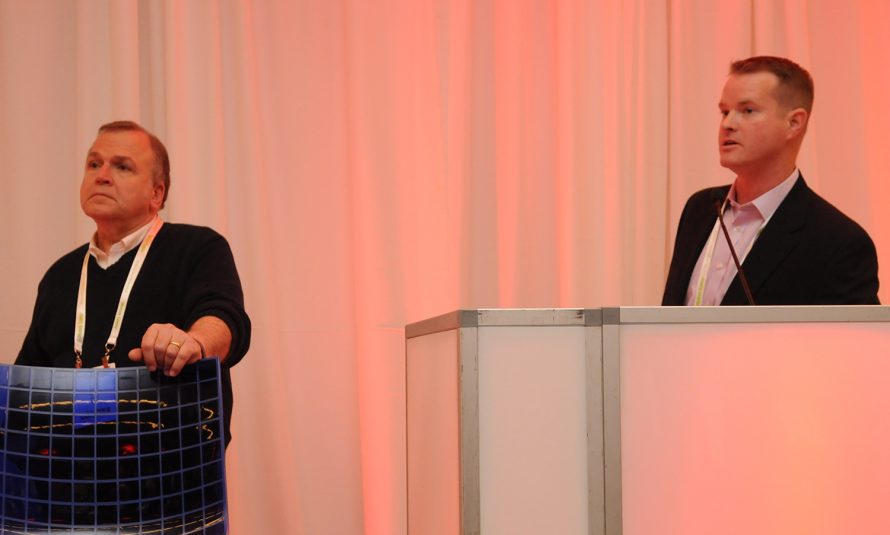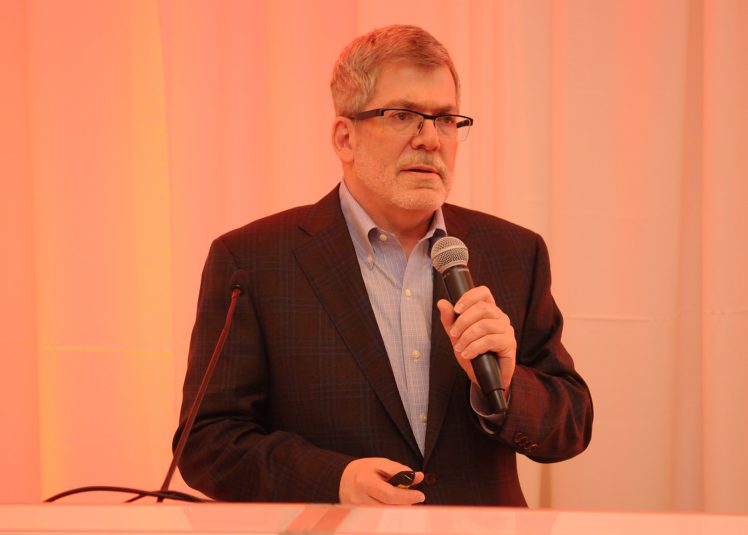SVG TranSPORT: Record Crowd Gets Inside Look at NBC Olympics’ Rio Efforts, ATSC 3.0 World Series Broadcasts
Story Highlights
SVG’s annual TranSPORT conference drew a record 200+ sports-production pros to the Microsoft Technology Center in New York City on Tuesday for a full afternoon of sessions addressing the current state and future of transmission, contribution, and distribution of live sports content. Headlined by a pair of keynotes examining NBC Olympics’ efforts for Rio 2016 and the historic ATSC 3.0 test broadcast of the World Series, the conference also featured the second-annual SVG TranSPORT Survey examining usage trends of fiber vs. satellite vs. IP transmission for live sports productions.

From left: David Chilson, associate director, broadcast distribution services, CBS; Chris Connolly, director, transmission engineering and maintenance, NBC Sports Group; Keith Goldberg, VP, global operations and transmission services, Fox Networks Group; Emory Strilkauskas, principal engineer, transport technologies and special projects, ESPN
Sessions included The Rise of IP Networks, Standardization Update on High Dynamic Range, 4K/HDR Delivery and HEVC Compression, How Multiple Streams Impact Live Sports Productions, and of At-Home Production. The 2016 SVG TranSPORT was made possible by Title Sponsor Aspera, Diamond Sponsors Haivision and The Switch, and Event Sponsors Comrex, Media Links, and Riedel.
SVG TranSPORT Survey: Fiber Up, Satellite Down, IP on the Horizon
This year’s SVG TranSPORT survey marks the second year that SVG has collected data from CBS Sports, ESPN, Fox Sports, NBC Sports, and Turner Sports in an effort to break down the usage of fiber, satellite, and IP/open internet for contribution/backhaul of nearly 27,000 live sports productions by these broadcasters in 2016.
The survey illustrates trends seen across the industry in recent years. Use of fiber increased to 76% of all backhaul (from 67% in 2015), satellite decreased to 20% (from 30% in 2015), and IP was up a tick to 4%. Broadcasters also project the breakdown for the 28,416 events expected in 2017: fiber at 79%, satellite 16%, and IP up slightly at 5%. Here is the full breakdown of the 2016 SVG TranSPORT survey:
From Rio to Stamford and Beyond: Inside NBC Olympics’ Transmission Schedule
This year’s TranSPORT also featured an inside look at NBC Olympics’ transmission scheme for the 2016 Rio Games, which was among the most ambitious and complex in the history of television. In all, more than 130 HD paths were transmitted from Rio de Janeiro to NBC Olympics’ Sports Production Operations Center in Stamford, CT, as well as to 30 Rock in New York (network distribution and news); AT&T New York (control and command), Englewood Cliffs, NJ (cable-channel master control); Orlando (Golf Channel); Hialeah, FL (Telemundo); Puerto Rico (Telemundo PR); and Denver (NBC backup facility).
NBC Olympics’ Chris Connolly, director of transmission engineering and maintenance, and Bob Kiraly, director of broadcast telecommunications operations, detailed NBC’s efforts, which deployed four 10-GBps circuits (as well as two satellite backup paths and two 1-GBps circuits to CBC in Canada for backup) to deliver 42+ at-home and other contribution feeds, 65+ host feeds, and 42 return feeds (contribution, monitoring, and IPTV). Media Links provided J2K hitless transmission, and Cisco DCM handled all IP-based transmission traffic.
ATSC 3.0 Makes History at World Series
The afternoon was also highlighted by a look at the recent ATSC 3.0 test broadcast at the World Series last month. Game 2 in Cleveland on Oct. 26 became the first-ever major pro sports event to be transmitted live using the ATSC 3.0 next-gen over-the-air transmission system, thanks to Fox affiliate WJW-TV Cleveland.
The presentation, delivered by ATSC Board Chairman Richard Friedel (EVP/GM, Fox Networks Engineering & Operations), detailed how Fox, Tribune Media, the NAB, and an army of tech partners teamed up to deliver the broadcasts. Using the newly standardized transmission system for the ATSC 3.0 standard, the experimental station simulcast network and local programming from WJW-TV as the Cleveland Indians hosted the Chicago Cubs at Progressive Field. The ATSC 3.0 broadcasts took place only for games played in Cleveland.
The ATSC 3.0 broadcasts used the transmitter and broadcast facilities of Tribune Media-owned WJW, which is serving as a living ATSC 3.0 laboratory for broadcasters and manufacturers (via NAB’s FCC-granted experimental license).
Technology deployed for the test included a Harmonic ATSC 1.0 to 3.0 transcoder, Triveni Digital ATSC 3.0 signal processing, a GatesAir ATSC 3.0 exciter, and LG Electronics ATSC 3.0 receivers. A 65-in. LG OLED TV received the over-the-air signal at the stadium to verify transmission and allow Fox execs and VIPs to view the ATSC 3.0 broadcast.



